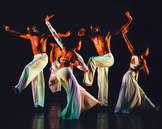|
 |
|
|
 |
 |
About the Author:
 Alvin Ailey American Dance Theaterwww.alvinailey.org
Alvin Ailey - Founder
Judith Jamison - Artistic Director
Judith H. Weill, Chairman of the Board of Trustees
Masazumi Chaya - Associate Artistic Director
Sharon Gersten Luckman —Executive Director
James King, General Manager
Amadea Edwards, Administrative Manager
Bernice Collins, Company Manager
Jodi Pam Krizer, Director, Marketing and Public Relations
Lynette Rizzo, Marketing Manager
Beth Olsen - Public Relations Manager
Cohn Davis Associates—Publicity
Review by Dr. Roberta E. Zlokower
December 20, 2002 Episodes (1989): Choreography by Ulysses Dove, Restaged by Masazumi Chaya, Original Music by Robert Ruggieri, Costumes by Jorge Gallardo, Lighting Design by John B. Reade, Performed by the Company. Ulysses Dove, listed as a "choreographer with a bold new voice", has created an electric, highly energetic event, with dancers, in somewhat interchangeable costumes, blasting from the wings like bursts of lightning, onto the stage in interplay between passion and violence. The dancers seemed to represent the human condition, as nine dancers, in varying partnerships, related to each other with themes of raw emotions. The sharp, hostile music sounded like subways or echo chambers, with percussive rhythms and angular choreography. Fists and kicks were the pattern, no soft formations or wanton smiles. Individual performers were showcased, as they repeatedly appeared in aggressive passages, sometimes forced into scenes, symbolic of rape or violence, sometimes appearing in scenes, symbolic of threat or peril. Linda Celsete Sims, Linda-Denise Fisher-Harrell, and Dwana Adiaha Smallwood (See Smallwood Interview), and Matthew Rushing were especially effective in bravura performances that provided quintessential tension and focus. Shelter (1988): Choreography by Jawole Willa Jo Zollar, Music by Junior "Gabu" Wedderburn, Texts "Between a Rock and a Hard Place at the Intersection of Reduced Resources and Reverberating Rage", by Hattie Gossett, "Belongo", by Laurie Carlos, "Endangered Species" drawn from various news sources, Text Read by Carl Hancock Rux, Costumes by Terri Cousar, Lighting by Meg Fox, Performed by Abdur-Rahim Jackson, Juan-Antonio Rodriguez, Amos J. Machanic, Jr., Anthony Burrell, Samuel Deshauteurs, Benoit-Swan Pouffer. Ms. Zollar, who holds a full professorship at Florida State University, is extremely sensitive and compassionate to the plight of the homeless and downtrodden, and is acutely aware of the element of chance, which can destroy lives. This sad story of life in the streets, with the full male cast miming the condition of fleas, delirium tremens, fear, cold, rage, and alienation, accomplished the shock value and portrayal of the dark side of life. The dancers appeared depressed and depraved, as they began lifeless and limp and proceeded to wild leaps and catapulting turns, with the energy that is significantly inherent in all Ailey productions. The use of spoken text underscored the horror and drew the audience in toward the performers and the atmosphere of angst. This piece was a daring venture for the Ailey administration. Grace (1999): (See Ailey Grace Review). On this night, I sat on the left, in contrast to my right seating for the last review of Grace. On the left, I was able to see the dancers, all deliberate and controlled, enter the stage from a different angle, through the bright, white lights, which cross from right rear to center/left front. The different levels of speed and tension of rhythm were not apparent on this viewing, but the ability to concentrate on the individual dancers and to notice their deliberate, controlled movements was well worth the second viewing. The entrances and departures, with poise and amazing posture, allowed me to feel the differing levels of speed of the individual performers, without the dynamic of the group choreography that was most apparent from the right side seating. I felt a sense of the celebration of life with the music of Duke Ellington's Come Sunday. 
Company Members
Ballet: Grace
Choreographer: Ronald K. Brown
Photo by Paul Kolnik

Company Members
Ballet: Grace
Choreographer: Ronald K. Brown
Photo by Paul Kolnik
|
|
|




